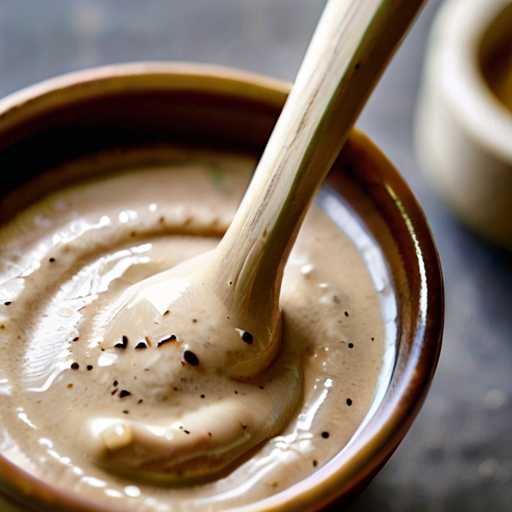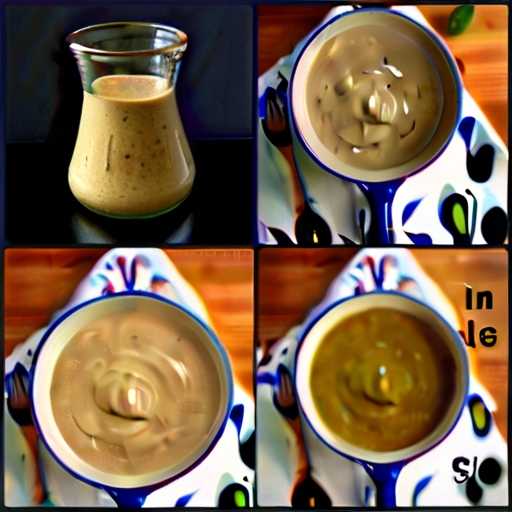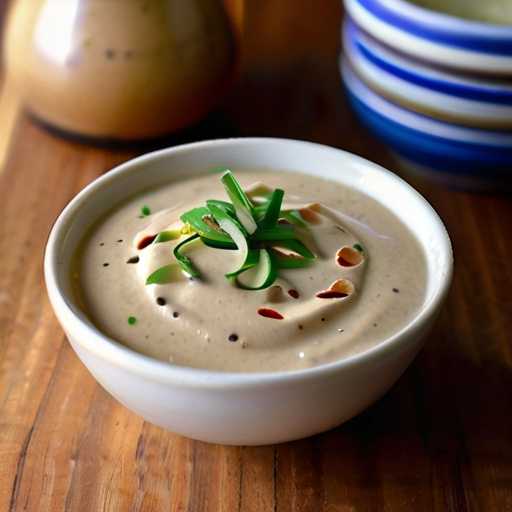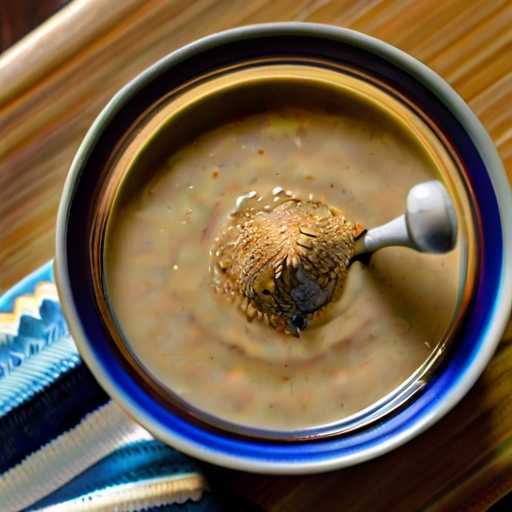Easy Homemade Creamy Sesame Dressing Recipe with Tahini
Creamy Sesame Dressing is a culinary delight that enhances any dish with its rich flavor. Originally derived from Asian cuisine, particularly Japanese and Middle Eastern traditions, this dressing embodies a harmonious blend of sesame seeds and tahini, a paste made from ground sesame seeds. The reason for its popularity is its versatility, adding a delicious accent to salads, wraps, and cereal bowls. This homemade recipe is notable for its simplicity and ability to enhance dishes with its nutty flavor, making it a staple in modern kitchens.
Easy Homemade Creamy Sesame Dressing Recipe with Tahini:
Cuisine
Middle Eastern
Difficulty
Easy
Preparation
10 minutes
Cooking
0 minutes
Ingredients for Easy Homemade Creamy Sesame Dressing Recipe with Tahini:
- Ingredients:
- • 1/4 cup tahini
- • 2 tablespoons soy sauce (or tamari if gluten-free)
- • Rice 2 tablespoons vinegar
- • 1 tablespoon honey (or maple syrup for a vegan version)
- • 1 tablespoon sesame oil
- • 1 garlic clove, minced (or 1/2 teaspoon garlic powder)
- • 1 teaspoon grated fresh ginger (or 1/2 teaspoon grated ginger)). )
- • Add thin dressing to 2-4 tablespoons water to desired consistency
- • Optional: 1 teaspoon Sriracha or hot sauce for a spicy touch
- • Salt and pepper to taste
- Substitutes:
- • Tahini: If unavailable, tahini, almond butter, or peanut butter can also be used as substitutes.
- • Soy Sauce: Tamari can be used as a substitute for soy sauce if you are looking for a gluten-free option.
- • Rice Vinegar: Instead of rice vinegar, you can use apple cider vinegar or white wine vinegar.
- • Honey: For a vegan version, you can use maple syrup or agave syrup in place of honey.
- • Sesame oil: If you don’t have sesame oil, you can use olive oil or other neutral flavored oil, but the sesame flavor will not be as pronounced.
- • Garlic: Garlic powder can be used as a substitute for fresh garlic.
- • Ginger: Ground ginger can be used in place of fresh ginger, but the taste may vary slightly.
- • Sriracha: You can use your favorite hot sauce in place of Sriracha. You can omit it if you prefer a milder dressing.
Cooking Instructions: Easy Homemade Creamy Sesame Dressing with Tahini
- Preparation:
- 1. First, assemble all required components and tools..
- 2. Mince the garlic and grate the ginger if it is not already grated.
- 3. Measure out tahini, soy sauce, rice vinegar, honey (or maple syrup), sesame oil, and water.
- 4. If desired, prepare optional garnishes such as sesame seeds and chopped green onions.
- Cooking Instructions:
- 1. In a small mixing bowl, combine tahini, soy sauce, rice vinegar, honey (or maple syrup), sesame oil, minced garlic, and grated ginger.
- 2. Mix ingredients until smooth and well mixed.
- 3. Stirring constantly, gradually add 1 tablespoon of water until the dressing has the appropriate consistency..
- 4. Taste the dressing and adjust seasoning as needed. If you like it spicier, add a pinch of red pepper flakes or a little Sriracha.
- 5. Once you are satisfied with the taste and texture, cover the bowl and refrigerate the dressing for at least 30 minutes to allow the flavors to meld.
- 6. Before serving, stir the dressing well to recombine all separated ingredients.
- 7. Serve the creamy sesame dressing on salads, grain bowls, or as a dip for vegetables.
- 8. Garnish with sesame seeds or chopped green onions, if desired.
- Important points to note:
- • Stir the tahini well before measuring to incorporate any oil that may have separated.
- • To get the right consistency, change the amount of water applied. Some people prefer a thicker dressing, while others prefer a more pourable dressing.
- • Chilling the dressing before serving enhances the flavor, but it can be used immediately if desired.
- • You can keep leftovers in the refrigerator for up to a week if you store them in an airtight container. Stir well before use.
Kitchen tools: Creamy Sesame Dressing
- 1. Mixing Bowl
- 2. Whisk or fork
- 3. Measuring cup and spoon
- 4. Blender or food processor
- 5. Storage jar or bottle with lid
- 6. Cutting board
- 7. Knife
- 8. Citrus press or reamer (for squeezing lemon juice)
- 9. Garlic press or grater (for mincing garlic)
- 10. Spoon or spatula (for scraping ingredients from a blender or food processor)
Flavor Tips for Perfection: Creamy Sesame Dressing

- 1. Quality Ingredients: Start with quality tahini and fresh ingredients like garlic, lemon juice, and sesame oil. Using fresh ingredients improves the overall flavor of the dressing.
- 2. Tahini consistency: Make sure the tahini is well mixed before using it in a recipe. In some cases, the tahini may separate. Therefore, please stir or shake well before measuring.
- 3. Balance of sweetness and spice: Adjust the amount of honey or maple syrup and lemon juice in the recipe to achieve a balance of sweetness and spice. Taste a little at a time and add more at a time until you reach your desired flavor profile.
- 4. Garlic Strength: If you like garlic, feel free to add a clove or two to intensify the garlic flavor. However, if you prefer a milder flavor, you can reduce the amount of garlic or even omit it completely.
- 5. Add salt to taste: Salt is very important to enhance the flavor of dressings. Start with a small amount and gradually add more until you get the right flavor. The salt content of tahini can vary, so adjust accordingly.
- 6. Creaminess and Texture: Achieve the perfect creamy texture by gradually adding water or olive oil until the desired consistency is reached. Be careful not to add too much liquid at once, as this may make the dressing too thin.
- 7. Roasted sesame seeds: For a more nutty flavor, consider roasting the sesame seeds before adding them to the dressing. Heat in a dry skillet over medium heat until golden brown and fragrant, then let cool before adding to the dressing.
- 8. Let it rest: Let the dressing rest in the refrigerator for at least 30 minutes to allow the flavors to meld before serving. This allows the garlic and other spices to infuse the tahini, creating a more flavorful dressing.
- 9. Adjust the spices: Feel free to experiment with additional spices, such as freshly grated ginger or a pinch of cayenne pepper, to add depth and complexity to the flavor profile. Be careful not to overpower the sesame flavor.
- 10. Consistency Check: Give your dressing a final taste before serving, adjusting seasonings and ingredients as needed to ensure the perfect balance of flavor.
Serving Suggestions: Creamy Sesame Dressing

- 1. To serve: Pour the creamy sesame dressing into a small elegant serving bowl or dressing bowl. Make sure the container is clean and visually appealing.
- 2. Garnish: Sprinkle toasted sesame seeds over the dressing or drizzle with extra virgin olive oil to add visual interest and enhance the nutty flavor. You can also add sprigs of fresh herbs, such as parsley or coriander, for a pop of color.
- 3. Side Dishes: Add a creamy sesame dressing to a variety of dishes for a rich, nutty flavor. Here are some suggestions:
- • Fresh Salads: Prepare colorful fresh salads such as mixed lettuce, spinach, arugula, and kale. Add chopped vegetables such as cucumbers, bell peppers, cherry tomatoes and grated carrots.
- • Grilled vegetables: Serve the dressing as a dip for grilled vegetables such as zucchini, peppers, eggplant, and asparagus. The creamy texture of the dressing pairs beautifully with the smoky flavor of the grilled vegetables.
- • Buddha Bowl: Create a nutritious Buddha Bowl with a base of cooked grains like quinoa or brown rice, topped with roasted sweet potatoes, chickpeas and avocado slices, and drizzled with a creamy sesame dressing. Sho.
- • Falafel wraps: Use the dressing as a spread on falafel wraps or sandwiches. The flatbread is stuffed with crunchy falafel balls, grated lettuce, diced tomatoes and cucumber slices, drizzled with creamy sesame dressing and wrapped.
- 4. Serve chilled: For the best taste and consistency, chill the creamy sesame dressing in the refrigerator for at least 30 minutes before serving. This will allow the flavors to meld and thicken the dressing slightly.
- 5. Enjoy: Invite guests to mix the dressing well before pouring it over their favorite dishes. The creamy texture and rich sesame flavor bring a new flavor to your everyday meals. Good appetite!
Storage and Leftovers: Creamy Sesame Dressing Recipe:

- 1. Storage:
- • Transfer remaining dressing to an airtight container with a tight-fitting lid. Glass containers are suitable for storing dressings.
- • Make sure the dressing has completely cooled to room temperature before sealing the container.
- • Store the container in the refrigerator. The low temperature helps keep the dressing fresh.
- • Always label the container with the date of preparation to determine freshness.
- 2. Reheating (if applicable):
- • If the creamy sesame dressing thickens or hardens in the refrigerator due to the presence of tahini, this is normal. Tahini tends to solidify as it cools.
- • Before reheating, remove the dressing from the refrigerator and let it sit on the counter for about 15 to 20 minutes to come to room temperature.
- • Once the dressing reaches room temperature, stir well to combine all separated ingredients and ensure a smooth consistency.
- • If you prefer a warmer dressing, gently reheat on the stove or in the microwave.
- • To reheat on the stovetop, pour desired amount of dressing into a small saucepan and heat over medium-low heat. To prevent sticking or burning, stir often.
- • If using a microwave, heat the dressing in a microwave-safe bowl in short intervals, stirring occasionally, until the desired temperature is reached. Be careful not to overheat the bandage, as this can cause it to loosen or become too thin.
- 3. Serve and enjoy:
- • Once reheated (if applicable), Creamy Tahini Sesame Dressing can be enjoyed again.
- • Use as a salad dressing, drizzle over grilled vegetables, or as a dip for a variety of dishes.
- • For best flavor and quality, refrigerate leftovers immediately and use within a few days.
Nutritional Values: Creamy Sesame Dressing
- • Calories: Approximately 80 to 100 calories per 2 tablespoons.
- • Fat: Approximately 7 to 9 grams per serving, primarily from tahini and additional oils.
- • Protein: Approximately 2-3 grams per serving, primarily from tahini.
- • Carbohydrates: Approximately 3 to 5 grams per serving, primarily from tahini and additional sweeteners.
- • Fiber: About 1 gram per serving, primarily from tahini and other fiber-rich foods like garlic and herbs.
- Please note that these values may vary depending on the specific ingredients and amounts used in the recipe.
Health Benefits of Homemade Creamy Sesame Dressing Recipe with Tahini:

- 1. Rich in essential nutrients: Made from sesame seeds, tahini is an excellent source of essential nutrients such as calcium, iron, magnesium, and phosphorous. These nutrients are important for bone health, muscle function, and overall energy production.
- 2. Heart-healthy fats: Sesame seeds are rich in unsaturated fats, especially omega-6 fatty acids, which, when consumed as part of a balanced diet, can lower bad cholesterol (LDL) levels and protect against heart disease. reduce the risk of
- 3. Antioxidant properties: Sesame seeds contain antioxidants such as sesamol and sesamin, which protect cells from free radical damage. This helps reduce inflammation and reduce the risk of chronic diseases such as cancer and diabetes.
- 4. Supports Digestive Health: Tahini is an excellent source of fiber, which is essential for maintaining healthy digestion. Constipation is avoided, regular bowel movements are encouraged, and the growth of good gut bacteria is supported by fiber.
- 5. Potential for blood sugar regulation: Some studies suggest that sesame seeds may help regulate blood sugar levels because they contain fiber and protein. Incorporating tahini in moderation into your diet can help control blood sugar levels, especially when combined with other nutritious foods.
- 6. Strengthens Immune Function: Sesame seeds contain zinc, which plays an important role in immune function and wound healing. Incorporating tahini-based dressings into your diet strengthens your immune system and helps your body fight infections.
- 7. May support weight management: Although tahini is high in calories, the high fiber and protein content in tahini can promote satiety and suppress appetite. When consumed in moderation as part of a balanced diet, it may help control weight.
- 8. Versatile and Flavorful: Making your own creamy sesame dressing lets you control the ingredients and adjust the flavor to your liking. By using healthy ingredients and avoiding additives in commercial dressings, you can enjoy healthier options that add flavor and nutrition to your meals.
DIY and Professional Bakery: Easy Homemade Creamy Sesame Dressing Recipe with Tahini

DIY (Do It Yourself): Creamy Sesame Dressing
- Advantages:
- Cost-effectiveness: Making creamy sesame dressing at home is cheaper than buying it online It will also be much cheaper. professional bakery. It is economical in the long run since you only need to purchase the materials.
- Customization: DIY allows you to customize the dressing to your liking. You can adjust ingredients like tahini, soy sauce, vinegar, and sweetness to your taste.
- Freshness: Homemade dressings are fresher because they are made from scratch. This allows us to use the freshest ingredients and avoid preservatives and additives that can be found in store-bought products.
- Ingredient Control: You can control the quality of ingredients used in dressings. You can choose organic or locally sourced ingredients, ensuring higher quality and healthier options.
- Disadvantages:
- Time consuming: Making creamy sesame dressing from scratch takes time and effort. You need to gather the ingredients, measure them, and mix them properly. Busy folks might not find it appropriate.
- Skills Required: Achieving the right balance of flavor and texture may require some culinary skill and experimentation, especially if you’re new to making dressings.
- Storage and Shelf Life: Homemade dressings typically have a shorter shelf life than store-bought dressings. There is a risk of damage if you do not use it within a certain period of time.
- Budget Considerations:
- Ingredients: When budgeting for DIY Creamy Sesame Dressing, consider the cost of each ingredient. Tahini, soy sauce, vinegar, and other seasonings vary in price depending on brand and quality. You can reduce costs by choosing private label or buying in bulk.
- Equipment: Consider the following equipment needed to prepare dressings: B. Blender or food processor. If you don’t already own these items, your initial investment may increase.
- Versatility: Consider the versatility of ingredients beyond just making dressings. If the tahini, soy sauce, or other ingredients can be used in other recipes, the initial investment may be justified.
Professional Bakery: Creamy Sesame Dressing
- Advantages:
- Convenience: Purchasing Creamy Sesame Dressing from Professional Bakery is convenient, especially for people with busy schedules or limited cooking skills. There is no need to prepare in advance, just pick it up or have it delivered.
- Consistency: Professional bakeries often have standardized recipes and manufacturing processes that ensure consistent quality of their products. That means you can expect the same taste and consistency every time you buy your dressing.
- Save time: When shopping at the bakery, you save time and effort in gathering, preparing, and mixing ingredients. This is an easy solution for people who need to change clothes on short notice or who don’t have time to do it themselves.
- Disadvantages:
- Cost: Purchasing creamy sesame dressing from a professional bakery can be more expensive than making it yourself, especially when you factor in the markup and additional costs of packaging and branding.
- 2. Limited customization: When shopping at a bakery, you have limited control over ingredients and flavors. You will have to rely on the bakery’s recipe and may not be able to adjust it exactly to your taste.
- 3. Preservatives and Additives: Some commercially available dressings may contain preservatives and additives to extend shelf life or improve flavor, or to accommodate specific dietary preferences or restrictions. may not match.
- Budget Considerations:
- • Price Comparison: Compare the cost of buying creamy sesame dressing at the bakery versus making it yourself, and consider which option is better in the long run, considering how much you need and how often you use it. Decide what is budget friendly.
- • Bulk purchases: Some bakeries may offer discounts for bulk purchases. Therefore, if you require a larger quantity of dressing, please contact us for pricing.
- • Quality aspect: Consider the quality of the ingredients used by the bakery. Using high-quality, fresh ingredients can justify the higher cost of making it yourself.
Budget-Friendly Option: Creamy Sesame Dressing

- Effordable Decoration Ideas:
- 1. Easy Mason Jar Decoration: You can give an empty mason jar a rustic look by painting it with chalk paint. Wrapping it around your neck with twine or ribbon creates a gorgeous look.
- 2. DIY Table Runner: Make a table runner from brown construction paper. Add a personal touch by decorating with hand-drawn designs or die-cut patterns.
- 3. Feature natural elements: Collect pine cones, twigs, and small stones from your garden or nearby park. Arrange them in a shallow bowl or tray to create a nature-inspired centerpiece.
- Creative Solutions:
- 1. Reusable fabric bunting: Cut triangles out of colorful fabric scraps or old clothing. You can tie them together with twine to make reusable bunting and hang them in your party area.
- 2. Upcycled glass jar vases: Put away empty glass jars and spray them with metallic or pastel colors. It can be used as a vase for fresh or dried flowers as an inexpensive and eco-friendly decoration option.
- 3. Photo Garland: Print your favorite photos onto cardstock or cardstock. Cut holes in the corners and tie them with twine to create a personalized photo garland that can be hung in the party room.
Variations to Try: Creamy Sesame Dressing

- 1. Spicy Kick: Add a pinch of cayenne pepper or a splash of hot sauce to give your dressing a spicy kick. Please adjust the amount according to your spiciness preference.
- 2. Sweet Sesame: Add 1 tablespoon of honey or maple syrup to sweeten the dressing. Tahini’s nutty flavor is balanced and pairs well with a variety of salads.
- 3. Garlic Infusion: Crush or finely chop garlic and mix it into your dressing for a spicy garlic flavor. Let it sit for a while to let the garlic flavor infuse into the dressing before serving.
- 4. Herb Infusion: Chop fresh herbs like coriander, parsley, and dill and mix them into your dressing for a bright herbal flavor. Experiment with different herbs to find your favorite combinations.
- 5. Citrus Zest: Grate the zest of a lemon or orange and add it to the dressing for a bright citrus flavor. Adds a refreshing taste to the creamy sesame base.
- 6. Soy Sensation: Add a little soy sauce to add more umami to your dressing. It adds depth of flavor and pairs well with Asian salads.
- 7. Creamy Coconut: Replace some of the tahini with coconut cream for a tropical flavor. This variation adds a subtle coconut flavor and creamy texture to the dressing.
- 8. Nut blend: Mix 1 tablespoon of almond or peanut butter with tahini for a nuttier flavor. This adds complexity and richness to the dressing.
- 9. Spicy Yogurt: Add a little Greek yogurt for a tangy and creamy consistency. This variation loosens up the dressing while preserving its creaminess.
- 10. Sesame Ginger: Add 1 teaspoon of grated fresh ginger to dressings for a spicy kick. The combination of ginger and sesame creates a dynamic flavor that pairs well with Asian salads.
Why this Easy Homemade Creamy Sesame Dressing Recipe with Tahini is outstanding

- 1. Unique Flavor Profile: Creamy Sesame Dressing has a unique flavor profile that sets it apart from other dressings. . Tahini, a paste made from ground sesame seeds, adds a rich, nutty flavor to any dish, adding depth and complexity. The earthy aroma of sesame seeds and creamy texture combine to create a harmonious balance that will please your taste buds.
- 2. Versatility: One of the great features of this bandage is its versatility. It’s great as a salad dressing, but its uses go beyond just vegetables. It’s also great as a marinade for grilled meats, a dip for vegetables, or as a flavorful topping for cereal bowls. Its high adaptability makes it an essential kitchen appliance for anyone looking to enhance a variety of dishes with minimal effort.
- 3. Simple and quick preparation: Despite its gourmet appeal, the preparation of this dressing requires minimal effort. With just a handful of ingredients and a few minutes of your time, you can whip up a batch of this creamy goodness in your own kitchen. Its simplicity makes it accessible to novice chefs while satisfying the discerning palates of experienced chefs.
- 4. Health Benefits: In addition to its delicious taste, this dressing offers numerous health benefits. Tahini is a nutrient-dense food packed with essential minerals like calcium, iron, and magnesium, as well as healthy fats and protein. By incorporating this dressing into your meals, you will not only increase the taste but also the nutritional value.
- 5. Homemade Delights: In a world of commercial dressings laden with preservatives and artificial ingredients, homemade alternatives stand out for their freshness and purity. Making your own creamy sesame dressing allows you to control the quality of the ingredients, giving you a healthier option without sacrificing taste.
Creamy Sesame Dressing with Tahini (Vegan, Gluten-Free)

- Ingredients:
- • 1/4 cup tahini
- • 2 tablespoons fresh lemon juice
- • 2 tablespoons tamari (gluten-free soy sauce)
- • 1 tablespoon rice vinegar
- • 1 maple syrup or agave syrup
- • 1 garlic clove, minced
- • 1 teaspoon grated fresh ginger
- • 2-4 tablespoons water (adjust to desired consistency)
- • Salt and pepper to taste
- Directions:
- 1 . Mix the ingredients. In a small mixing bowl, mix together tahini, fresh lemon juice, tamari, rice vinegar, maple syrup, minced garlic, and grated ginger.
- 2. Adjust the viscosity: Depending on the desired consistency, gradually add water to the mixture and stir until the desired consistency is achieved. Add more water as necessary after using the first two teaspoons.
- 3. Season: Taste the dressing and adjust with salt and pepper as needed. Adjust additional seasonings as needed.
- 4. Chill (optional): For best flavor, chill the dressing in the refrigerator for at least 30 minutes before serving. Additionally, it will enable the tastes to blend.
- 5. Serving Instructions: Use the creamy sesame dressing as a delicious topping on salads, drizzle over steamed vegetables, or as a dip for raw vegetables. Enjoy our homemade, vegan and gluten-free dressings.
Recipe Notes: Creamy Sesame Dressing

- 1. Tahini Selection: If you choose tahini for this recipe, choose a quality brand made only from sesame seeds, without added oils or sweeteners. This ensures a clean flavor and smooth texture for the dressing.
- 2. Sesame Oil: Roasted sesame oil adds an extra rich nutty flavor to the dressing. Be sure to use toasted sesame oil instead of regular sesame oil for the best flavor.
- 3. Adjust the consistency: You can adjust the consistency of the dressing by adding more or less water according to your preference. To thicken the dressing, use less water. To thin the consistency, gradually add water until the desired consistency is reached.
- 4. Sweetness and Spice: Adjust the balance of sweetness and spice by varying the amounts of honey or maple syrup and rice vinegar. Taste the dressing a little at a time and adjust the ingredients to your liking.
- 5. Garlic and ginger: Fresh garlic and ginger add delicious depth to the dressing. If you prefer a milder flavor, you can reduce the amount of garlic and ginger or even omit them completely.
- 6. Storage: Store leftover dressing in an airtight container in the refrigerator for up to 1 week. Shake or stir well before use, as it will loosen easily when it cools.
- 7. Versatile: This creamy sesame dressing is great on salads, but can also be used as a delicious dip for raw vegetables, as a flavorful marinade for grilled chicken or tofu, or as a delicious sauce for pasta or grain bowls. .
- 8. Cultural Significance: Sesame-based dressings have roots in a variety of cuisines, including Japanese, Middle Eastern, and Mediterranean cuisines. Because sesame seeds are rich in nutrients such as calcium, iron, and magnesium, they add depth and flavor to dishes and are often enjoyed for their health benefits.
- 9. Customize: Feel free to adjust this recipe to your own taste preferences by experimenting with additional ingredients such as soy sauce, miso paste, chili flakes, or fresh herbs such as coriander and parsley.
FAQ: Easy Homemade Creamy Sesame Dressing Recipe with Tahini:
- What is tahini? Where can I find it?
- Middle Eastern and Mediterranean cuisine frequently uses tahini, a paste produced from sesame seeds. Tahini can usually be found in the spices and international food sections of most grocery stores and specialty food stores.
- Is homemade sesame dressing healthier than store-bought?
- Homemade sesame dressing is healthier than store-bought because you have control over the ingredients. By using high-quality tahini and adjusting the amount of oil and sweetener, you can create a healthier menu with fewer preservatives and additives.
- Can I customize the flavor of the sesame dressing?
- Yes, you can easily adjust the flavor of the sesame dressing to suit your taste. You can adjust the amount of sweeteners like tahini, lemon juice, and honey, and spices like garlic and ginger to achieve your desired flavor.
- What is the expiration date and how to store homemade Creamy Sesame Dressing Recipe?
- Homemade creamy sesame dressing will usually last for 1 to 2 weeks when stored in an airtight container in the refrigerator. Shake or stir well before use as separation may occur over time. If you notice any signs of decay, such as: an unpleasant odor or an unsightly appearance, discard the bandage.
- How to use homemade creamy sesame dressing?
- Homemade creamy sesame dressing can be used in many ways. It makes a great salad dressing for mixed vegetables and Asian-style salads with vegetables such as cabbage, carrots, and peppers. You can also use it as a dip for raw or roasted vegetables, drizzle over grilled meat or tofu, or as a sauce for pasta or grain bowls. The possibilities are endless!
In summary, this homemade creamy sesame dressing recipe with tahini provides a delicious combination of flavors and textures. Tahini, lemon juice, garlic, and sesame oil combine to create a rich, flavorful dressing that’s perfect for salads and dips. Adding honey will balance the flavor, and adding water will give you the desired consistency. Easy to prepare and versatile, this Creamy Sesame Dressing Recipe refines any dish with its nutty, creamy flavor.






